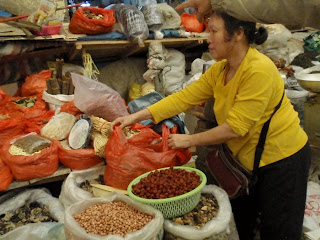The lack of dairy seems to be a problem in the village. We see old people who are terribly bent over from osteoporosis.

Some of the food I made that day.

Our cooking school.


Yes, it's true. Those are dogs.

Bunnies and chickens. You choose,and they slaughter on the spot for you.

Pigs' snouts.

Pigs' tongues.

Green teas.

She stands over a bowl of goji berries. They are rare and expensive in the States, but common here, and a great garnish for food, with a sweet/sour taste.

The vegetable at bottom right is loofa sponge. It is edible when picked young and tender.

Live frogs in net bags.

Food is laid out on mats. Everyone crouches on the floor for transactions.

Chopping the heads off of snails. They are easier to eat that way.

I take a trip into a town for a one-day cooking school. First we walk through the local market. The produce is in large quantities, incredibly varied, clean and of wonderful quality. Prices are impossibly cheap. The abundant, inexpensive food of this country is a great key to its success.

This was our chance to absorb the life of the Chinese countryside, and to rest after
frenetic Shanghai. But the rabid consumerism that has spread through this country is also here, in the town of Yangshou, nearby. Everywhere people approach us to sell their wares, relentless. On the television, advertising takes up most of the time. I sense a silent, official push to increase demand and public spending. Advertising seems even more like propaganda here. We are grateful to be outside of town. The village is peaceful. Evening comes.

This one looked abandoned, but we saw people living on their boats.



rafts made of bamboo.



We spent a day kayaking down a tributary of the Li river.


The buildings are hand pounded mud brick. This woman was covered with flies that fluttered when she moved.



Wwe are staying in this converted farmhouse outside of Yangshou, in southeastern China. Behind us is a small farming village. This area is about forty degrees south of Houston, and quite tropical. We are only about a hundred miles from Hanoi.
Everywhere there are small family plots filled with thriving crops. The ground is fertile and rainfall is abundant.

It is hard to imagine the profile of these karst mountains. They are made of limestone, and filled with faults that allow water to seep through and erode them from the inside. At one ancient time, this entire area was level at the elevation of the tops of these mountains. We have found the source of the immpossibly shaped mountains in old Chinese scrolls, those tall, u-shaped humps that I had thought were fantasy.
No comments:
Post a Comment